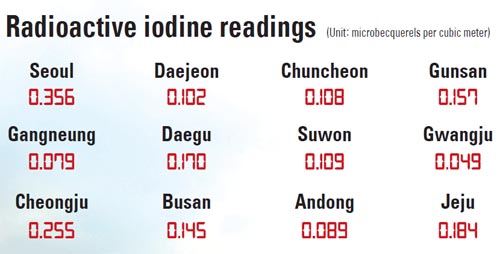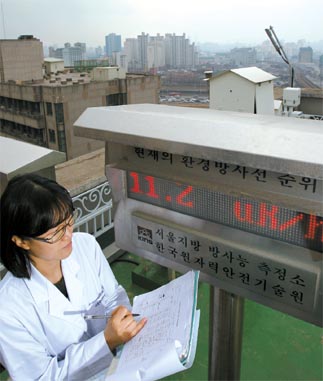Fallout detected all across nation

“We have found miniscule amounts of radioactive iodine in all 12 regional detection areas from aerial samples, and the detection center in Chuncheon picked up radioactive cesium,” said Yun Choul-ho, the head of the Korea Institute of Nuclear Safety, during a press briefing yesterday.
The institute detected the radiation Monday morning and announced the results yesterday, as it takes about 22 hours to fully analyze the materials found, it said.
Korea has state-of-the-art technology when it comes to radiation detection, which was installed originally “not to detect environmental radiation,” Yun said, “but for underground nuclear tests, very small amounts of radioactive isotopes and xenon.”

A radiation detector at the Korea Institute of Nuclear Safety in Haengdang, Seongdong District, indicates levels of 11.2 microroentgens per hour, the equivalent of 112 nanosieverts, within the normal 110 to 210 nanosieverts range. By Kim Do-hoon
“Because of this, our [technological] ability is among the highest in the world,” Yun said.
According to Yun, radiation levels for iodine found in the country varied from as low as 0.049 millibecquerels to 0.356 millibecquerels. The KINS chief did not say which area had the highest radiation level.
“At this rate, these levels are 1/200,000 or 1/30,000 of 1 millisievert that Koreans are exposed to annually and have basically no effect on the human body,” said Yun.
Workers at nuclear plants and other occupations that involve handling nuclear material are subject to an annual limit of 20 millisieverts a year.
“On special occasions it can be raised to 50 millisieverts a year, but there is also a cap of 100 millisieverts for five years,” Yun said.
Kim Seung-dae, a spokesman for the Korea Meteorological Administration, said that the iodine and cesium were thought to have traveled the same way xenon found in Gangwon had: on winds from Japan that traveled north to the Arctic and then south through Siberia to the Korean Peninsula.
Yun said that cesium was found only in the Chuncheon area. Cesium is the heaviest of the three materials found and can’t drift as far.
“The radiation is coming now, but these are very miniscule amounts, and the same thing is happening all over the world,” Yun said.
“With the amounts detected in our country, I will tell you there is no need for change, not even in the slightest, in your lives,” Yun said.
In Japan, however, Prime Minister Naoto Kan is being pressured to expand the evacuation area in Fukushima Prefecture after plutonium was found in the soil at the stricken power plant yesterday, according to Tokyo Electric Power Co. The highly carcinogenic material, found in five different locations at the plant, may have come from spent fuel rods stored in the reactors at the site, said Tepco.
Japan’s Nuclear and Industrial Safety Agency said that though the plutonium levels were not harmful to humans, the material found on the site could signify a breach in the containment vessel at one or more reactors.
Japan’s chief government spokesman Yukio Edano said early yesterday that the discovery of plutonium at the plant was possible evidence that some of the fuel rods had partially melted down and called it a “very serious situation.”
After trying for days to cool the reactors at the plant, Tepco is now making massive efforts to keep the turbine rooms and pipes from overflowing with contaminated water.
Seawater pumped into the reactor buildings is now radioactive after having come into contact with fuel rods.
By Christine Kim [christine.kim@joongang.co.kr]
한글 관련 기사 [중앙일보]
일본 방사능 한반도 전역 상륙 … 전국 12곳 세슘·요오드 극미량 검출
“과거 기준 집착 말고 최악 가정해 대비를”
“일본 후쿠시마(福島) 원자력발전소 사태가 최악으로 치닫더라도 한국은 문제 없다.”
국내 원자력 전문가들은 일본에서 건너온 방사성 물질이 “인체에 전혀 영향을 주지 않는 극미량”이라며 이렇게 말했다. 29일 중앙일보가 마련한 긴급 좌담회 자리에서다.
일본 에 비하면 한국 원전은 훨씬 안전하다는 평가도 나왔다. 이은철 서울대 원자핵공학과 교수는 “후쿠시마 원전은 전기가 끊어지면 냉각수를 공급할 수 없지만, 한국 원전은 높이·온도차에 의해 냉각수 일부가 자연 순환된다”며 “40일 안에만 전력을 복구하면 된다 ”고 말했다.
하지만 일부 개선해야 할 사항도 지적됐다. 강신헌 한국수력원자력 안전기술처장은 “우리 원전은 최고 높이 3m 정도의 쓰나미에 대비해 설계됐다” 고 말했다. 일본과 달리 지진 발생시 원전 가동을 자동으로 중지시키는 기능도 없다. 한수원 측은 지난주 자체 점검에 이어 현재 외부 전문가들의 안전진단을 받고 있다. 강 처장은 “진단 결과를 반영해 고쳐야 할 것은 확실히 고치겠다”고 말했다. 후쿠시마 원전은 과거 안전 기준을 고수하다 이번에 큰 피해를 입었다.
한편 한국원자력안전기술원(KINS)은 이날 전국 12개 측정소에서 방사성 요오드가 검출됐다고 밝혔다. 강원도 춘천에선 세슘도 나왔다.
◆MB “방사능 검사 결과 신속히 공개”=이명박 대통령은 이날 일본 방사능 문제와 관련, “국민들이 안심할 수 있게 검사 결과를 신속하고 투명하게 공개하고 검출량과 관련해서는 쉽게 국민들에게 설명할 필요가 있다”고 지시했다.










with the Korea JoongAng Daily
To write comments, please log in to one of the accounts.
Standards Board Policy (0/250자)